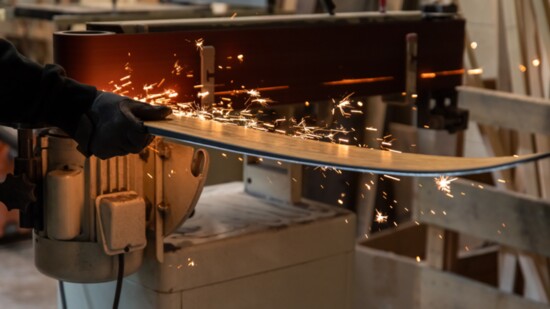Hinterland’s proud “ski misfits” have been creating a name for themselves handcrafting skis since 2009. And they’ve done it all by the sweat of their brow.
While their tight-knit team comprises the types you’d love to grab a beer with on the slopes, they do not play around when building top-of-the-line skis for “the people who are out there skiing every single day the lift is running or in the backcountry,” as CEO and one of the originating founders, Creighton Elinski, puts it. “Whether that be the pros, heli guides, ski guides, local folks, and everybody in between.”
Handcrafting each pair of skis with love might be an understatement; insert “obsessively” and you get closer to the truth. No cracks get past the nose of builder and craftsman, Matthew Fritz (also known as “Fritz”), who comes from a long line of craftsmen himself. His job is to make all of “Creighton’s wild ideas a reality,” as he says.
In an arduous and meticulous ten-hour process, Fritz has his hands on the tiniest of details—building the sidewalls, cutting all the pieces and components by hand, and guaranteeing that not only every pair of Hinterland skis is a literal work of art but is built to endure a beating on the mountain.
Because where other enterprises cut corners to increase their bottom line, the steadfast team takes an “off-piste” or counter approach. “If there is a better material on the market, we'll find it and we'll use it. And if there are better build techniques, we'll spend the extra time to develop the tools or create the processes to make that ski just a little bit better in every single way we can,” the earnest CEO explains.
And well, the proof is in the skis. They’ve built skis for clients that have lasted the test of time—15 years strong (since they opened) and aspiring to last a lifetime. Known to even get better with time, Fritz adds, "They break in, they don't break down."
Maybe not so ironically, the Hinterland team is also built to last. They’ve remained intact through plenty of their own rough terrain—enduring times of feast and famine all while staying committed to the heart of their brand and each other. This is the major reason why partner and investor, Jared Turner, was drawn to the nimble crew and wanted to help them take their brand to greater heights.
"What impressed me was that the skis are incredible, high quality, and have a beautiful aesthetic. They're the best skis in the world, but it was their camaraderie as a team—usually guys who have worked together as long as they have, have a beef, but they didn’t have issues and they've had some hard times,” he says.
Why Utah? Besides the obvious proximity to the mountains (they can have a prototype ready and on the mountains in three days), they fell in love with the unique die-hard ski community here that has stuck with them through the good, the bad, and the ugly.
“Utah was a bit of a strange place to move 10, 20, 30 years ago,” Creighton says. “So you know that the people here are here for a reason. The skiers are very passionate and kind of stuck through the woes of Salt Lake City and did it all for skiing. So there's a lot of heart here.”
Fritz echoes his sentiment, “I feel like I finally found my place of mountain misfits. I would want to support anything they do, so I'm very encouraged by their support of what I'm doing.”
This exchange of local support spills into their love of the environment and giving back as well. Creighton's extensive eco-conscious background has caused them to take extra measures. Even while locally sourcing most of their material, they are aware of the sport's environmental impact. Partnering with Tree Utah, they are revegetating the Wasatch Front in areas damaged through skiing, hiking, and foot traffic by planting two trees for every pair of skis they sell.
Beyond their ambitious plans for the ski brand—including a goal of sponsoring the Salt Lake City 2034 Winter Olympics—Hinterland has a surprise in store for early next year: groundbreaking innovations in ski design.
Their latest models, the Highmark and Highmark 95, are tailored to different skiing experiences. The Highmark is for carving and front-side slopes and the Highmark 95 is for variable terrain and smooth skiing that combines multiple models into one, making it much less demanding than some of their other styles.
“Even if they're from beginner to intermediate, we've got a quality product for them here that they can use and grow on as they work towards being an expert skier,” Creighton concludes.
To purchase your handmade skis or to schedule a shop visit, see their website: https://hinterlandskis.com
“If there is a better material on the market, we'll use it. And if there are better build techniques, we'll spend the extra time to make that ski just a little bit better in every single way we can."
- Creighton Elinski, Hinterland CEO
